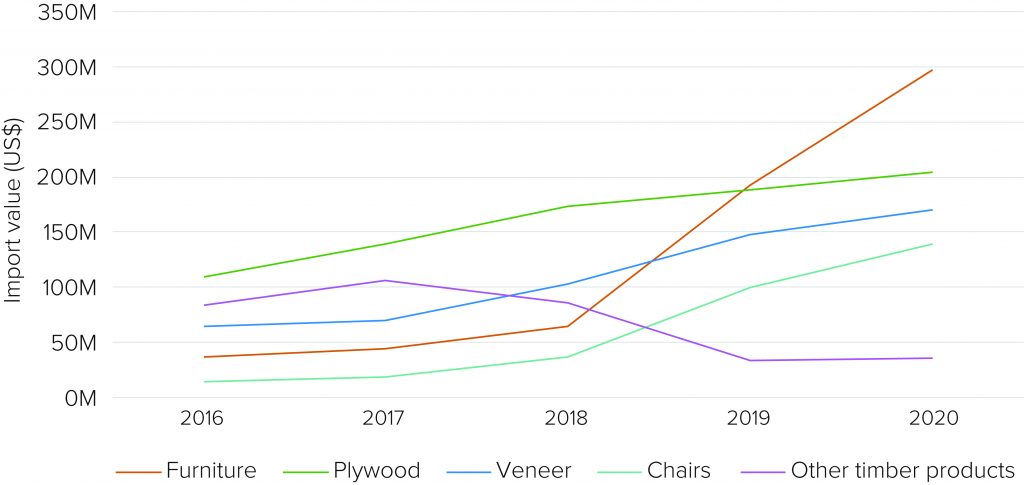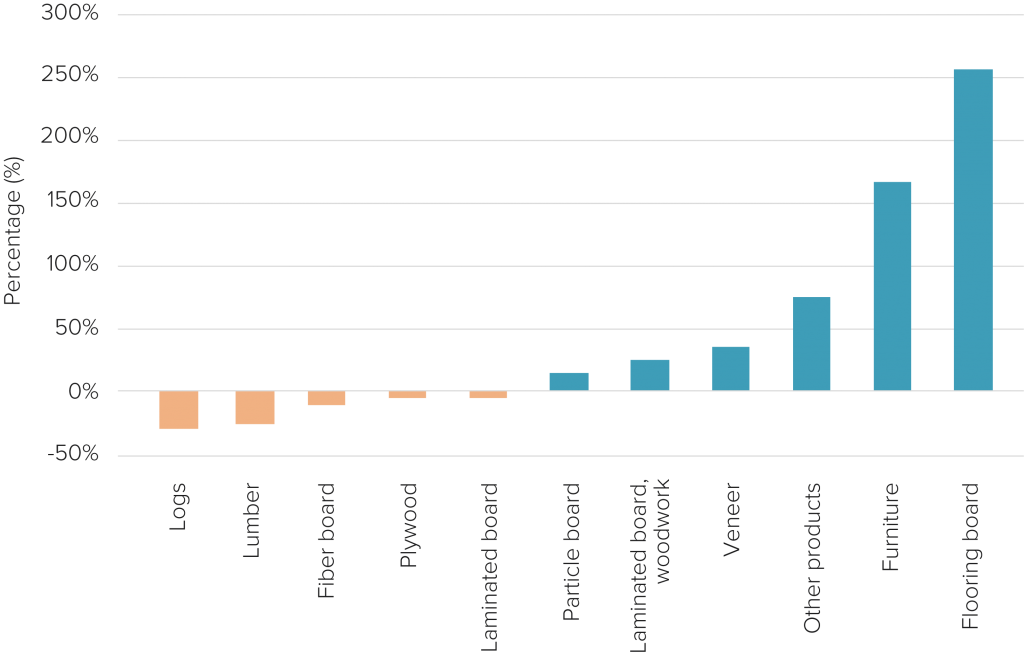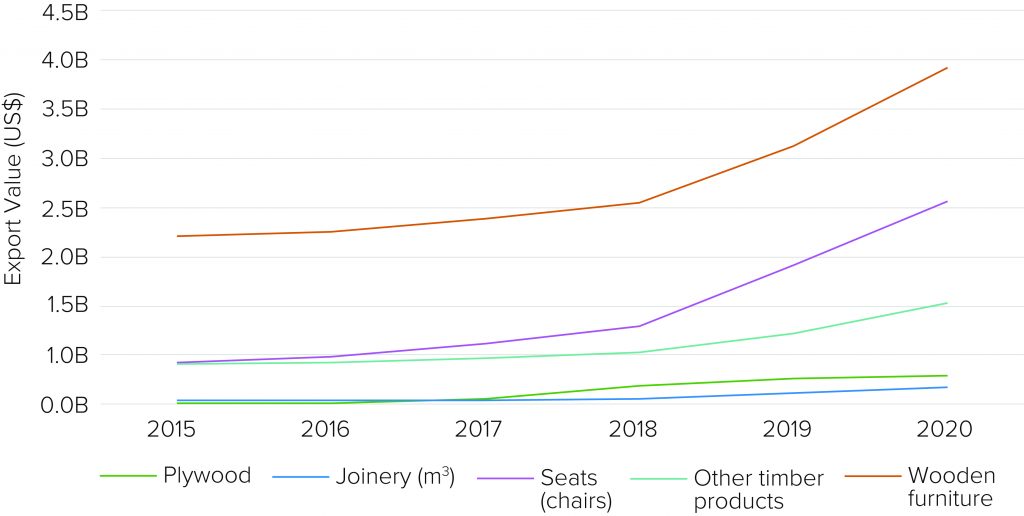On January 27, 2022, U.S. Customs and Border Protection (CBP) issued a final “affirmative determination” under the Enforce and Protect Act against the BGI Group (aka the U.S. Cabinet Depot). The CBP ruled that BGI fraudulently evaded antidumping (AD) and countervailing duties (CVD) on wooden cabinets and vanities imported from Vietnam. It was found that the majority of value of the cabinets were made in China, although recognized that some components were added in Vietnam.
The case revealed that after the AD/CVD orders were imposed on cabinets and vanities from China in April 2020, BGI began importing ready-to-assemble cabinets from a Vietnamese company called HOCA Kitchen and Bath Products International Co. (“HOCA Vietnam”) and had a previous history of importing these items direct from China. U.S. import data also revealed a surge in cabinet imports from Vietnam from April 2020. It was found that HOCA Vietnam, established by Hangzhou HOCA Kitchen & Bath Products, China, lacked the capacity to produce the volume of cabinets being exported to the U.S., and was importing cabinet doors and frames from its Chinese parent company.
It was also noted that HOCA Vietnam imported “substantial” (CBP 2022, p.2) volumes of wooden furniture components from China and incorporated them into ‘ready-to-assemble’ kits imported by RGI. Furthermore an “industry official” observed that “60% of the total value of a complete cabinet is represented by the cabinet doors and drawers … {t}he typical rule of thumb holds that the doors, drawer fronts, and frames comprise 2/3 of the value and even more of the value add {sic} of a complete cabinet.” (CBP 2022, p.15). While not mentioned in the public version of this case (CBP 2022) this observation is significant in the light of Vietnam’s Certificate of Origin requirements – if 40 percent or more of a product’s value is made abroad, it should not (legally) be labelled as “made in Vietnam.”
The ruling means that a significant proportion of wooden cabinet imports from Vietnam will now be subject to tariffs, at a rate to be determined by the US Commerce Department and likely to range between 59-84%. Morever, these rates will also be applied retroactively to “millions” of cabinets imported since March 2020 from Vietnam. BGI alone imported over US$40 million of cabinets from Vietnam in 2020, and may be liable for millions of dollars of unpaid duties. As Betsy Natz, CEO of the Kitchen Cabinet Manufacturer’s Association (KCMA) said “this determination should serve as a strong deterrent to others that are currently or considering evading the AD/CVD orders” (Adams 2022).
The case has established a vital precedent on the legal definition of “transshipment” and after what levels of processing a product can switch its country of origin label. The decision overcame the defense of BGI that AD/CVDs do not apply when Chinese components undergo further processing in a transit country. In the case of Vietnam, showing fraudulent transshipment has also been complicated by the more complex supply chains resulting from the recent surge in China’s investment in Vietnamese wood manufacturing businesses to take advantage of lower labor and raw material costs. Until now the strategy of assembling the cabinets (or other products) from parts or components imported into the transit country from China, and/or mixing them with parts from the transit country, has worked for companies like RGI to stay legal and avoid the duties. But this strategy now appears much riskier for its protagonists.
There have been two previous similar cases involving transshipment of kitchen cabinets to the United States. In one of these, involving transshipment via Malaysia, the plaintiff was successful, but in the other one, involving transshipment through Cambodia, and also with BGI as the defendant, it was ultimately unsuccessful due to the lack of “substantial evidence that BGI engaged in evasion.”
In the successful case, a company called MasterBrand noted a very rapid rise in cabinet imports from Malaysia, and hired a private investigator to find out what was happening. MasterBrand subsequently submitted documentation to U.S. Customs alleging that wooden cabinets and vanities produced in China were being repackaged in Malaysia and shipped to the U.S., thus avoiding the duties. In May 2021 MasterBrand, with the support of AKCA, filed 11 requests for investigations under the Enforce and Protect Act. Subsequently the CBP found “substantial evidence” that four importers had circumvented AD/CVD duties.
While not providing anything approaching evidence or ‘proof’, timber trade data analysed by Forest Trends would also seem to support the allegations that Chinese timber products have been accessing the US market via Vietnam, possibly illegally. Vietnam’s imports of timber products targeted by US tariffs / duties rose significantly since 2018, while imports of several non-targeted products from China fell from 2017 to 2020 (Figure 2). For example, Vietnam Customs’ import data reveal that Key informants in Vietnam have also noted that imports of components/parts from China were often disguised or hidden in shipments of furniture and plywood. While a surge in imports into Vietnam from China is not a problem, it does raise a flag that re-routing in order to evade trade tariffs may be happening, and claims of Vietnam country of origin must be checked more diligently.
Figure 1. Vietnam’s timber product imports from China by value 2016-2020 (Vietnam Customs’ data)

Source: Forest Trends, VIFOREST, FPA Binh Dinh, HAWA & BIFA Research Team. 2021.Vietnam – China Timber Trade Report 2015 – 2020: Situation and Trends. Hanoi.
Figure 2. Percentage change in Vietnam’s Imports from China 2017-2020

During the same period, there was also a major surge in Vietnam’s exports of wood furniture and seats to the US, while China’s exports of these products to the US faltered. The export value of these products from Vietnam to the US rose 93 percent in value over 2018-2020 compared to 33 percent over 2016-2018; and the number of pieces of furniture and seats (combined) rose 118 percent over 2018-2020 compared to 13 percent over 2016-2018. Between them wooden furniture (including parts) and seats comprised 92 percent of Vietnam’s export value to the US in 2020. Although relatively less important, the export volume of joinery products from Vietnam to the US rose 176 percent over 2018-2020 compared to 23 percent over 2016-2018 (see Figure 3).
Figure 3. Vietnam’s timber product exports to US by value 2015-2020

While AD/CVD evasion has been the target of these CBP investigations, a recent US / Vietnam 301 investigation focused on Vietnam’s imports of illegally harvested or traded timber and transhipment. Vietnam has made significant progress developing its Vietnam Timber Legality Assessment System (VNTLAS) to reduce its imports of high-risk timber and timber products, but similar policy processes in China have languished despite evidence of significant imports of timber at high risk of having been illegally harvested and entering into China’s supply chains. The VNTLAS will need to ensure it is appropriately designed and sufficiently implemented to be able to effectively monitor the legality of the complex supply chains being imported from China, such as these highly processed kitchen cabinets and components.
REFERENCES:
CBP. 2022. January 27, 2022. EAPA Case Number 7603. Public Version. U.S. Customs and Border Protection.
https://www.cbp.gov/sites/default/files/assets/documents/2022-Feb/01-27-2022%20-%20TRLED%20-%20Notice%20of%20Determination%20%28508%20Compliant%29%20-%20%287603%29%20-%20PV.pdf
Larry Adams. 2022. U.S. Customs & Border Protection finds U.S. Cabinet Depot evading cabinet duties. February 4, 2022. https://www.woodworkingnetwork.com/cabinets/us-customs-border-protection-finds-us-cabinet-depot-evading-cabinet-duties
Schagrin Associates. 2022. Customs Acts on Kitchen Cabinet Duty Evasion. January 28, 2022.
https://www.schagrinassociates.com/post/customs-acts-on-kitchen-cabinet-duty-evasion
Robert Dalheim. 2021. Customs finds cabinet importers evaded Chinese duties by transshipping through Malaysia. Woodworking Industry News. September 21, 2021
https://www.woodworkingnetwork.com/news/woodworking-industry-news/customs-finds-cabinet-importers-evaded-chinese-duties-transshipping
Kitchen & Bath Design News. U.S. Action Reported on Tariff Evasion By Chinese Cabinet, Vanity Importers. February 4, 2021. https://www.kitchenbathdesign.com/u-s-action-reported-on-tariff-evasion-by-chinese-cabinet-vanity-importers/
U.S. Customs & Border Protection. EAPA Case N0. 7520 Public Version. July 21, 2021 https://www.cbp.gov/sites/default/files/assets/documents/2021-Jul/07-21-2021%20-%20TRLED%20-%20Final%20Determination%20Notice%20%28508%20compliant%29%20-%20%287520%29%20-%20PV.pdf
Viewpoints showcases expert analysis and commentary from the Forest Trends team.
Connect with us on Facebook and Twitter to follow our latest work.
